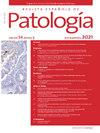Diagnostic challenges of retroperitoneal leiomyosarcoma: A case of confusion with adrenal tumour
IF 0.5
Q4 Medicine
引用次数: 0
Abstract
Leiomyosarcoma (LMS) represents an aggressive neoplasm that often involves a diagnostic challenge when encountered in atypical anatomical sites. The case here exposed involves a 70-year-old female with a retroperitoneal mass measuring 65 mm × 65 mm, likely of adrenal origin, warranting consideration for adrenalectomy. Histopathological examination reveals spindle cells arranged in intersecting fascicles, displaying pleomorphism and necrosis, and is immunohistochemically positive for actin and desmin markers. The definitive diagnosis is LMS, demonstrating venous origin without infiltration of the adrenal gland. Regrettably, the patient succumbed to post-operative complications. The inconspicuous nature of LMS in this anatomical niche complicates preclinical detection, underscoring the pivotal role of histopathological analysis in its identification. Furthermore, achieving complete excision proves challenging, resulting in a poorer prognosis compared to conventional LMS, despite the availability of alternative treatment modalities. Given the absence of standardized management protocols, a multidisciplinary approach remains essential.
腹膜后平滑肌肉瘤的诊断挑战:一例与肾上腺肿瘤混淆
平滑肌肉瘤(LMS)是一种侵袭性肿瘤,当遇到非典型解剖部位时,通常涉及诊断挑战。本病例涉及一名70岁女性,腹膜后肿块大小为65mm × 65mm,可能起源于肾上腺,需要考虑肾上腺切除术。组织病理学检查显示梭形细胞排列在交叉束中,表现多形性和坏死,肌动蛋白和desmin标记物免疫组织化学阳性。最终诊断为LMS,显示静脉起源,没有肾上腺浸润。遗憾的是,患者死于术后并发症。LMS在这一解剖生态位的不明显性质使临床前检测复杂化,强调了组织病理学分析在其鉴定中的关键作用。此外,实现完全切除证明具有挑战性,尽管有其他治疗方式,但与传统LMS相比,预后较差。由于缺乏标准化的管理协议,多学科方法仍然是必不可少的。
本文章由计算机程序翻译,如有差异,请以英文原文为准。
求助全文
约1分钟内获得全文
求助全文
来源期刊

Revista Espanola de Patologia
Medicine-Pathology and Forensic Medicine
CiteScore
0.90
自引率
0.00%
发文量
53
审稿时长
34 days
 求助内容:
求助内容: 应助结果提醒方式:
应助结果提醒方式:


